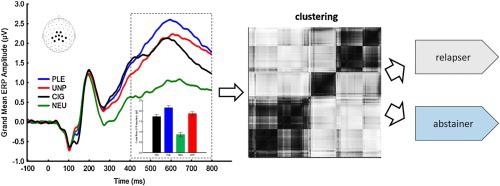当前位置:
X-MOL 学术
›
J. Neurosci. Methods
›
论文详情
Our official English website, www.x-mol.net, welcomes your
feedback! (Note: you will need to create a separate account there.)
Modeling neuroaffective biomarkers of drug addiction: A Bayesian nonparametric approach using dirichlet process mixtures.
Journal of Neuroscience Methods ( IF 2.7 ) Pub Date : 2020-05-16 , DOI: 10.1016/j.jneumeth.2020.108753 George Kypriotakis 1 , Paul M Cinciripini 1 , Francesco Versace 1
Journal of Neuroscience Methods ( IF 2.7 ) Pub Date : 2020-05-16 , DOI: 10.1016/j.jneumeth.2020.108753 George Kypriotakis 1 , Paul M Cinciripini 1 , Francesco Versace 1
Affiliation

|
BACKGROUND
The properties of neurophysiological processes related to addiction have received much attention in the literature. However, empirical evidence of meaningful and useful characterization of these processes is limited. Recent studies have found that electrophysiological responses to emotional and drug-related cues can be used to create profiles that reliably predict smoking relapse.
NEW METHOD
This paper evaluates the validity of classifying electrophysiological responses into distinct profiles using a Bayesian dirichlet process mixture (DPM) model. The DPM is a Bayesian nonparametric (BNP) method to modeling unknown number of profiles characterized by uncertainty in cluster membership and in cluster number.
RESULTS
The DPM model confirmed previously identified neuroaffective reactivity profiles, but also revealed a finer level of granularity in the clustering. Specifically, in addition to the two clusters previously identified in the literature, the BNP methods identified a cluster of individuals showing similar responses to smoking, pleasant, neutral and unpleasant cues.
COMPARISON WITH EXISTING METHODS
BNP models provide an alternative to the k-mean clustering approach to modeling EEG-based neuroaffective profiles. Unlike k-means clustering, BNP models compute the probability that a subject belongs to a cluster while taking into consideration uncertainty in the number of clusters.
CONCLUSIONS
Our results confirm the reliability of the two clusters previously identified in these data, but also provide new insights by revealing a cluster that presented similar responses to stimuli with different contents. This finding may be related to the uncertainty in classification or overlapping brain-reactivity profiles.
中文翻译:

药物成瘾的神经影响生物标志物建模:使用狄利克雷过程混合物的贝叶斯非参数方法。
背景与成瘾相关的神经生理过程的特性在文献中受到了很多关注。然而,这些过程有意义和有用的表征的经验证据是有限的。最近的研究发现,对情绪和药物相关线索的电生理反应可用于创建可靠地预测吸烟复发的概况。新方法 本文评估了使用贝叶斯狄利克雷混合过程 (DPM) 模型将电生理反应分类为不同特征的有效性。DPM 是一种贝叶斯非参数 (BNP) 方法,用于对未知数量的轮廓进行建模,特征在于集群成员资格和集群数量的不确定性。结果 DPM 模型证实了先前确定的神经情感反应特征,但也揭示了聚类中更精细的粒度级别。具体来说,除了先前在文献中确定的两个集群之外,BNP 方法还确定了一组对吸烟、愉快、中性和不愉快提示表现出相似反应的个体。与现有方法的比较 BNP 模型为基于 EEG 的神经情感特征建模提供了一种替代 k 均值聚类方法的方法。与 k-means 聚类不同,BNP 模型在考虑聚类数量的不确定性的同时计算主题属于聚类的概率。结论我们的结果证实了先前在这些数据中确定的两个集群的可靠性,但也通过揭示对不同内容的刺激表现出相似反应的集群提供了新的见解。
更新日期:2020-05-16
中文翻译:

药物成瘾的神经影响生物标志物建模:使用狄利克雷过程混合物的贝叶斯非参数方法。
背景与成瘾相关的神经生理过程的特性在文献中受到了很多关注。然而,这些过程有意义和有用的表征的经验证据是有限的。最近的研究发现,对情绪和药物相关线索的电生理反应可用于创建可靠地预测吸烟复发的概况。新方法 本文评估了使用贝叶斯狄利克雷混合过程 (DPM) 模型将电生理反应分类为不同特征的有效性。DPM 是一种贝叶斯非参数 (BNP) 方法,用于对未知数量的轮廓进行建模,特征在于集群成员资格和集群数量的不确定性。结果 DPM 模型证实了先前确定的神经情感反应特征,但也揭示了聚类中更精细的粒度级别。具体来说,除了先前在文献中确定的两个集群之外,BNP 方法还确定了一组对吸烟、愉快、中性和不愉快提示表现出相似反应的个体。与现有方法的比较 BNP 模型为基于 EEG 的神经情感特征建模提供了一种替代 k 均值聚类方法的方法。与 k-means 聚类不同,BNP 模型在考虑聚类数量的不确定性的同时计算主题属于聚类的概率。结论我们的结果证实了先前在这些数据中确定的两个集群的可靠性,但也通过揭示对不同内容的刺激表现出相似反应的集群提供了新的见解。











































 京公网安备 11010802027423号
京公网安备 11010802027423号